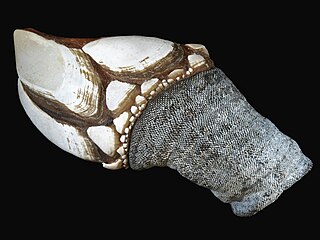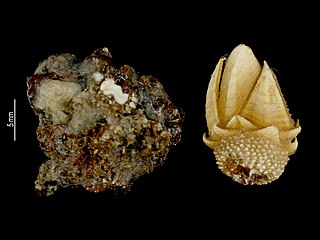
A barnacle is a type of arthropod constituting the subclass Cirripedia in the subphylum Crustacea, and is hence related to crabs and lobsters. Barnacles are exclusively marine, and tend to live in shallow and tidal waters, typically in erosive settings. They are sessile (nonmobile) and most are suspension feeders, but those in infraclass Rhizocephala are highly specialized parasites on crustaceans. They have four nektonic larval stages. Around 1,000 barnacle species are currently known. The name Cirripedia is Latin, meaning "curl-footed". The study of barnacles is called cirripedology.

Goose barnacles, also called stalked barnacles or gooseneck barnacles, are filter-feeding crustaceans that live attached to hard surfaces of rocks and flotsam in the ocean intertidal zone. Goose barnacles formerly made up the taxonomic order Pedunculata, but research has resulted in the classification of stalked barnacles within multiple orders of the infraclass Thoracica.

Thoracica is an infraclass of crustaceans which contains the most familiar species of barnacles found on rocky coasts, such as Semibalanus balanoides and Chthamalus stellatus. They have six well-developed limbs, and may be either stalked or sessile. The carapace is heavily calcified. The group includes free-living and commensal species.

Thecostraca is a class of marine invertebrates containing over 2,200 described species. Many species have planktonic larvae which become sessile or parasitic as adults.

The Chthamalidae are a family of chthamaloid barnacles, living entirely in intertidal/subtidal habitats, characterized by a primary shell wall of eight, six, or four plates, lacking imbricating plate whorls, and either membraneous or more rarely calcareous basis. They are not found below immediate subtidal habitats, and more likely are found in the highest tier of shallow-water barnacle fauna. They can be found in the most rigorous wave-washed locations, and some species are found in the surf zone above high tide mark, only receiving water from wave action at high tide.

Notochthamalus scabrosus, the only species in the genus Notochthamalus, is a species of barnacle found along the south-western and south-eastern coasts of South America, from Peru to the Falkland Islands. The species is found almost exclusively higher in the intertidal zone than the mussel Perumytilus, often codistributed with the confamilial barnacle Jehlius cirratus and Balanus flosculus.

Calanticidae is a family of acorn barnacles in the order Calanticomorpha. There are about 12 genera and more than 60 described species in Calanticidae.
Pseudoctomeris sulcatus is a species of barnacle, the only member of the genus Pseudoctomeris. It has an eight-plated shell wall with the rostrum partially fused with adjacent rostrolatera. The suture lines are visible only from the inside, thus in exterior view, the shell appears to have six wall plates. The basis is calcareous. Opercular plates are higher than wide, and not deeply articulated. These features and others show strong relationship to family Pachylasmatidae, and taxonomic revision of Pachylasmatidae has resulted in the transfer of Pseudoctomeris from Chthamalidae to Pachylasmatidae.
The Catophragmidae are a family of barnacles in the superfamily Chthamaloidea with eight shell wall plates, surrounded by several whorls of imbricating plates. The basis is membranous.

Catomerus is a monotypic genus of intertidal/shallow water acorn barnacle that is found in warm temperate waters of Australia. The genus and species is very easily identified by whorls of small plates surrounding the base of the primary shell wall; no other shoreline barnacle species in the Southern Hemisphere has that feature. This species is considered to be a relic, as these plates are found only in primitive living lineages of acorn barnacles or in older fossil species. The fact that this is an intertidal species is unusual, because living primitive relic species are often found in more isolated habitats such as deep ocean basins and abyssal hydrothermal vents.
Catolasmus is one of two monotypic Catophragmid acorn barnacle genera recognized in the Northern Hemisphere. It is easily identified by its prominent whorls of imbricating plates surrounding the main wall plates. It is quite large, attaining 55 mm diameter. Catolasmus represents one of the relictual lineages of the basal balanomorph radiation.
Catophragmus is the originally named genus of the family Catophragmidae. At present, it is monotypical. It is a shallow water acorn barnacle of the Tropical Western Atlantic and Caribbean characterized by small accessory imbricating plates surrounding the base of the shell wall.
Chamaesipho is a genus of four-plated notochthamaline barnacles in the Pacific Ocean limited to Australian/New Zealand temperate waters. They are intertidal in preference, and tend to form crowded columnar colonies. They can be identified in the field by having a four-plated wall, an unfused rostrum, and narrow opercular plates. Elminius, which also inhabits the same area, has four plates in its shell wall. However, in Elminius, the rostrum and rostrolatera are fused completely, and the compound rostrum receives the alae of the adjacent carinolaterals. In Chamaesipho, the unfused rostrum bears alae, and closely resembles the carina in appearance.

Chamaesipho brunnea is an intertidal barnacle common in New Zealand, in both the North Island and the South Island. Juveniles have six shell wall plates, reducing to four in adults, and with age, all plates become concrescent, with no trace of sutures inside or out. Shell is brown colored. The related, and sometimes associated Chamaesipho columna is much smaller in size, by nearly half, while Elminius, which can associate with both species, also has four shell wall plates, but plates remain distinct at all stages. The shell of C. columna corrodes to a pitted surface, while that of C. brunnea has a lamellar corrosion.

Chamaesipho columna is the type species for the barnacle genus Chamaesipho. Originally, species concept, as refined by Darwin472 consisted of C. columna. Spengler's 1790 description included specimens from "Otaheite" (Tahiti), which were far larger than any of the three described species. As Chamaesipho is restricted to Australia and New Zealand, and Spengler's Tahiti material lacked opercular plates, it is no longer included as Chamaesipho. Spengler's written description agrees with Chamaesipho.472 Spengler's Tahiti material is thought to be New Zealand Epopella, mislabeled.
Chamaesipho grebneffi is the first extinct member of the Notochthamalinae to be described, and the oldest chthamaloid barnacle known. This species is a fully derived Chamaesipho, and indicates a considerable antiquity for Chthamaloidea.
Rehderella is an unusual and monotypic barnacle genus restricted to Easter Island and Pitcairn Island. Rehderella belyaevi is its only species.
The barnacle genus Nesochthamalus was erected by Foster & Newman, 1987, to include sole species Chthamalus intertextus originally named by Darwin in 1854. It is widespread on islands in Western Pacific Ocean, including Hawaii, and presents combinations of unusual features which make easily recognizable for field workers. These include dirty white shell exterior with deep purple colored interior, operculars colored purple. Opercular plates on each side calcify together in all but youngest individuals, and cannot be separated or easily distinguished from each other. This feature is shared only by Rehderella belyaevi, but in latter species, scutum and tergum can be distinguished by raised ridge replacing old articular margin. Unique feature of Nesochthamalus is its basis. In young individuals, it is entirely membraneous, and with age, becomes secondarily calcareous progressively inwards, leaving only the center membraneous. As the basis calcifies, it rises off the substrate forming a saucer shape when viewed from the side. In addition, interior of shell is secondarily calcified.

Calanticomorpha is an order of acorn barnacles in the class Thecostraca. There are 3 families and more than 90 described species in Calanticomorpha.










